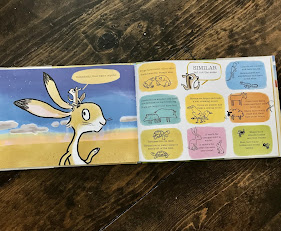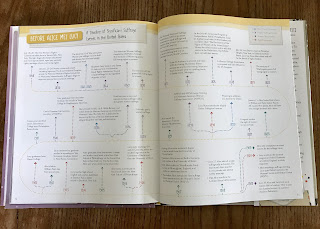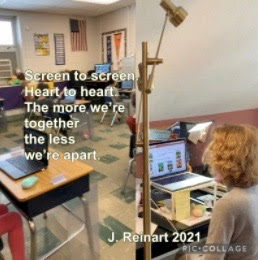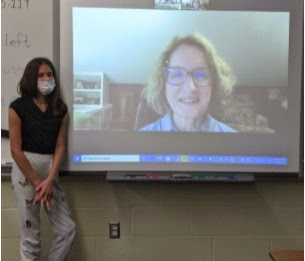by Sue Heavenrich
Today we’re going to chat with Vicky Fang about writing STEAM books for kids. But first, a peek at her newest book, Cupcake Fix (Layla and the Bots). Layla is a rock star and an inventor. Her robots Beep, Bop, and Boop help her design and build her inventions.
In this newest addition to the series, Layla wants to help the community center make their Grand Opening a smashing success. She decides to build a machine that can bake, frost, and decorate cupcakes on demand. We see the Bots in action, and Layla doing some serious problem-solving when the machine breaks down at the last minute.
This is a fun chapter book presented in graphic panels with a mix of text and speech bubbles. Aimed at young independent readers, this book (as with others in the series) includes Back Matter – a hands-on STEM activity.
Vicky joins us today for a talk about tech.
Sue: What made you decide to integrate technology, engineering, and coding in the stories you write?
Vicky: Before I became a writer, I was a product designer at Google, designing for kids and families. I love designing with technology, and wanted to share that creativity and magic with kids! I also think that computer literacy and computational thinking are important for all kids to understand, whether or not they want to become engineers. They are such important skills for any kid to navigate and problem solve in today’s world.
Sue: Can you tell us a bit about what being a product designer is all about, and how your background informs the way you write for kids?
Vicky: As a product designer, I am in charge of designing how the product should be experienced. That can include how you interact with it, what it looks like, what it sounds like, etc. I have an undergraduate degree in Theatre and Math, and an MFA in Design and Technology. As eclectic as that all sounds, the skills all fit together perfectly for designing awesome things with technology! The process I use to design products is the same process I use to write books - and can be applied to any kind of problem solving in my life. I love talking about that with kids, because I want them to feel empowered to break down and solve problems in their own lives.
Sue: In each book in Layla and the Bots series, Layla has a problem to solve. In Cupcake Fix, she collects data through conducting a survey, then designs and builds the cupcake machine, and develops code to tell the machine how to work. Talk about how – and why – you wanted to show this process.
Vicky: I’m always excited to sneak in different tools and techniques into the stories. In the first three books, there are examples of different research techniques, from observation, to user interviews, to surveys. I try to do the same with the technology they are exploring. Maybe they’re talking about sensors, or coding logic, or soundwaves. I just want to expose kids to all kinds of ideas! As for the process, they go through a pretty classic iterative design process. I have an accompanying activity packet that describes what I call The Invention I’s: Investigate, Ideate, Implement, Improve. It’s a process that Layla and the Bots use in every book, and one that kids can use in any sort of design challenge.
Sue: I love how Layla has to fix the machine because it couldn’t deal with human behavior. That given the choice of three toppings, the first person to test the machine chose all three. Talk about how we can incorporate this attention to debugging problems into our lives.
Vicky: I think this is a callout to the importance of prototyping and trying things out! You'll probably learn something you didn’t expect. You’ll probably fail along the way! The design process is an iterative one—you'll find new problems even as you create solutions. And you have to just keep being creative and persevering until you sort it all out. Sounds a lot like life!
Sue: I am a big fan of back matter, and love that yours is hands-on exploration oriented.
Vicky: I love back matter too! The Branches books (Scholastic) often have backmatter, so it wasn’t something I had to convince them of. Plus, the books so naturally lend themselves to some sort of hands-on activity. I originally had backmatter that talked about the Invention I’s, but we changed it to be more specific creative STEM activities that accompany each story. This makes more sense, since it’s a series – and every book has its own distinct backmatter!
Sue: Who decided to make it graphic novel style? It’s such a great way to get additional info (such as coding) presented.
Vicky: I modeled the manuscript off of similar Scholastic Branches books (like Cyndi Marko’s Kung Pow Chicken or Andrew Joyner’s Boris), so it was always intended to be heavily illustrated, but I didn’t have it specified in comic-style panels. I don’t know who decided on that style; I guess it was probably my wonderful editor, Rachel Matson! I’m pretty sure that she suggested creating a consistent "invention diagram" style that appears in each book!
Sue: What a fun series. Thank you, Vicky, for joining us today.
Vicky: Thank you so much for having me. I’m so excited to see kids’ creativity sparked by these books. I love seeing drawings inspired by the characters, or inventions based on the stories, or kids who tell me they want to grow up to be engineers or designers like Layla! I’m so grateful for all the teachers and librarians who have been doing fantastic programs with the books and their students. And I can’t wait for Book 4 coming out next year!




























